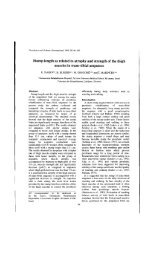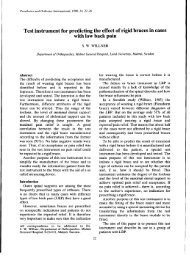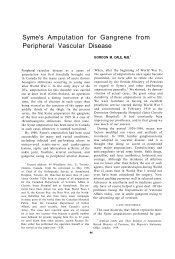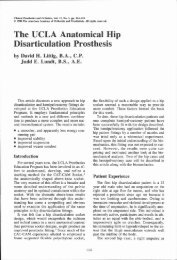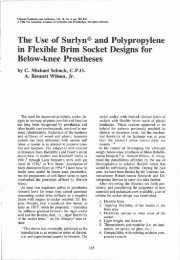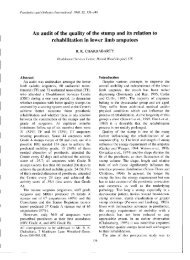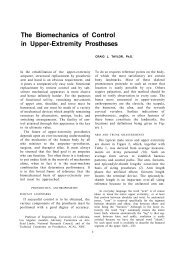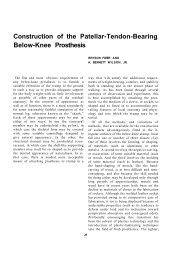Pro-Corn - O&P Library
Pro-Corn - O&P Library
Pro-Corn - O&P Library
You also want an ePaper? Increase the reach of your titles
YUMPU automatically turns print PDFs into web optimized ePapers that Google loves.
lack durability. Subsequently, thickness in the<br />
neighborhood of 80-90/1000" were specified<br />
and are preferred. (Note: NYU prefers<br />
60/1000".)<br />
Frame<br />
configuration<br />
At least three different configurations have<br />
been described for quadrilateral sockets. The<br />
differences center on the lateral wall and the<br />
amount of support considered necessary for the<br />
femur.<br />
A variety of designs have been put forth in<br />
order to achieve specific features in non-quadrilateral<br />
sockets, including the well known total<br />
flexible brim.<br />
Mr. Pritham concluded his presentation by<br />
saying, "the crucial point would seem to be<br />
that flexibility is independent of socket shape<br />
and can be modified to provide specific design<br />
features in a socket-frame system. The specific<br />
configuration depends upon the prosthetist's<br />
experience and fitting philosophy and the needs<br />
of the individual patient."<br />
Rounding out the first day of presentations<br />
was Dr. Robin Redhead, Senior Medical Officer<br />
at the Roehampton Limb Fitting Centre in<br />
London. Dr. Redhead's paper was entitled<br />
"Experience With Total Surface Bearing<br />
Sockets." This presentation centered more on<br />
weight-bearing distribution and biomechanics<br />
than on socket design or shapes. Dr. Redhead<br />
and associates maintain that regardless of<br />
socket shape or design, well distributed<br />
weight-bearing can eliminate the need for<br />
single point, bony weight bearing (such as ischial<br />
weight-bearing). This system of well distributed<br />
weight-bearing was referred to as a<br />
total-surface-bearing socket. It infers a hydrostatic<br />
type of socket fit utilizing the incompressibility<br />
of the fluids in an above-knee residual<br />
limb.<br />
This presentation brought a reaction from of<br />
<strong>Pro</strong>fessor Radcliffe, who doesn't agree with the<br />
hydrostatic concept of weight-bearing in prosthetics.<br />
He stated that "you need a closed<br />
system for hydrostatics and the AK residual<br />
limb is not a closed fluid system. With an open<br />
fluid system, the fluids are pushed out."<br />
There was considerable discussion on this<br />
topic, both pro and con, and it was never resolved.<br />
Beginning the morning of the second day,<br />
John Sabolich, C.P.O., from Oklahoma City,<br />
and Glenn Hutnick, CP., from New York,<br />
presented another view of CAT-CAM. As<br />
stated earlier, Tim Staats, C.P.O. reported that<br />
the UCLA CAT-CAM is evolving independently<br />
of the CAT-CAM technique of the original<br />
developers.<br />
Sabolich and Hutnick report that the original<br />
CAT-CAM is continuing to evolve and develop.<br />
Sabolich stated that, "it took five to six<br />
years to develop the current medial wall design,<br />
which has become increasingly more aggressive<br />
in enclosing and capturing the ischial<br />
ramus." They advocate use of the total flexible<br />
brim. "The key is the flexible brim system—it<br />
is totally flexible in the proximal area, where<br />
most patients complain." Aside from 100% use<br />
of the total flexible brim, the Sabolich/Guth<br />
CAT-CAM differs from NSNA and the UCLA<br />
CAT-CAM by not advocating the 4° to 7° medial<br />
lean of the foot, pylon, and knee bolt in<br />
bench alignment as proposed by Long and<br />
UCLA. John Sabolich went on to say "this additional<br />
adduction or tilting of the knee bolt is a<br />
cover-up for lost stability due to inadequate ischial<br />
containment." Mr. Long's response was<br />
that this was incorrect. <strong>Pro</strong>bably the most noticeable<br />
aspect of design that separates the Sabolich/Guth<br />
CAT-CAM apart from the other<br />
recent ischial-containment designs is the earlier<br />
mentioned aggressive capture of the ischial tuberosity<br />
and ramus. Sabolich claimed that they<br />
are enclosing more and more of the ischial<br />
ramus, as much as possible and still allow<br />
pubic ramus comfort. This ramus enclosure<br />
provides two biomechanical functions: (1) a<br />
medial bony stop for ML stability, and (2) rotational<br />
control, especially on soft fleshy residual<br />
limbs. Other than these departures, the Sabolich/Guth<br />
CAT-CAM differs very little from<br />
the UCLA CAT-CAM, especially in terms of<br />
brim shape, trimlines, and biomechanics. Sabolich,<br />
unlike Long, does advocate the use of<br />
dynamic alignment devices.<br />
At this point in the Workshop, <strong>Pro</strong>fessor<br />
Radcliffe returned to the podium in an attempt<br />
to present and clarify the comparative biomechanical<br />
principles of both quadrilateral and ischial-containment<br />
sockets. The following biomechanical<br />
analyses are taken from <strong>Pro</strong>fessor<br />
Radcliffe's discussion and from the paper he



